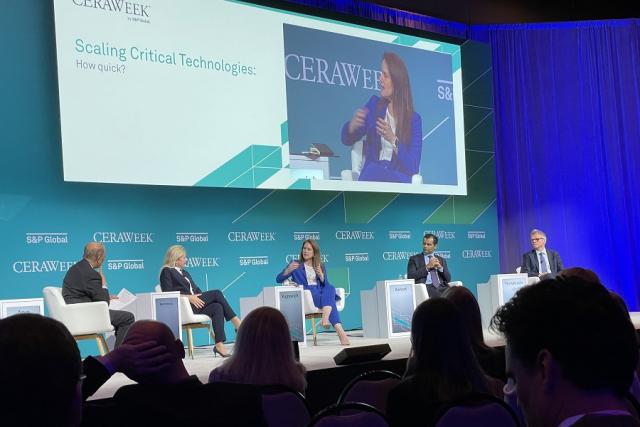
Moderator Atul Arya of S&P Global, and speakers Dr. Katharina Beumelburg of SLB, Zoe Yujnovich of Shell, Muqsit Ashraf of Accenture and Peter Terwiesch of ABB discuss the necessity of business models to scale technology at CERAWeek by S&P Global. (Source: Hart Energy)
Learn more about Hart Energy Conferences
Get our latest conference schedules, updates and insights straight to your inbox.
The tools needed to profit off reducing emissions already exist in the form of carbon capture and storage, hydrogen fuel, large duration storage and advanced nuclear energy, said Katharina Beumelburg, chief strategy & sustainability officer at SLB, during a panel at CERAWeek by S&P Global on scaling critical technologies.
“I truly believe that the solution for the biggest challenge that we as humanity have is technology,” she said. “And most of those solutions, like carbon capture and storage or hydrogen solutions are already here and available.”
However, there is still another hurdle to overcome: scale.
According to the International Energy Agency’s Net Zero Roadmap for the global energy sector, 50% of emissions reductions in 2050 are expected to come from technologies that are not yet available at a scalable level. Beumelburg, who holds a doctorate in robotics and automation, agreed with that assessment. She said that the industry is searching for the right business model to “bring technologies to a cost level that can be scaled.”
Electrification is one way to achieve scalable energy solutions. Peter Terwiesch, president of process automation at ABB, sees the potential in electrification. Fifty percent of the world's energy is consumed by electrical motors, with only about a quarter of them having a variable speed drive as an energy efficiency tool. Terwiesch sees electrification as not just an efficiency tool, but a conduit for renewable power generation.
“We’ve had electrification since the second Industrial Revolution, so there’s a wealth of knowledge and a certain scale that's been achieved already, yet there's a lot more efficiency potential in the system,” Terwiesch said.
Another way to bring emissions down and costs to a more scalable level is through the continued use and advancement of renewable technologies. The infrastructure is already there.
“The benefits of [renewables] is that they leverage existing infrastructure but also allow us to decarbonize some of the broader energy systems that we have today,” said Zoe Yujnovich, upstream director at Shell.
Despite the successes of electrification and renewable energy sources, simply providing different power sources isn’t enough, Yujnovich said. The commercial business model maturation is what makes scalable solutions complex.
“Particularly in the last year, we learned that energy affordability is critical to the sustainability of so many industries. A lot of the cement and steel industries are struggling with energy costs, and at the same time we’re asking them to make commitments for the next decade around the cost of decarbonization,” she said. “You can imagine how these commercial conversations are incredibly complex, and if you can’t get that right, you cannot scale anything. It doesn’t matter about the technology opportunities.”
Revolutionizing the business model
The key for change in the energy sector will be development of an innovative business model that allows organizations in the energy sector to scale otherwise uneconomical technology.
“What is going to really turn this into a revolution would be the combination of policy, infrastructure, investments and business model innovation,” Muqsit Ashraf, lead strategist for Accenture, said during the panel discussion. “If you take that business model innovation out, the revolution fizzles away.”
Ashraf sees partnering with other organizations as a way to create a successful business model.
Avelia — Accenture’s partnership with Shell and companies in the technological, financial and travel sector — was able to become a successful blockchain-powered, sustainable aviation fuel marketplace through the power of its book and claim business model.
Technologies can only be scaled if there’s an investment flowing through them, which won’t happen if the technology is unprofitable, Ashraf said. To “disrupt the vicious cycle” of attempting to scale inefficient technologies, “you need a range of capabilities and you need some syndication of risk financially” to be able to scale these technologies.
Atul Arya, senior vice president and chief energy strategist at S&P Global Commodity Insights, summed up the conclusions of the panel by observing that partnership are great but scaling up critical technologies “sounds like a contact sport.”
“You have to get in each other’s face to get this going,” Arya said. “It’s going to take a village. Nobody can do it alone.”
Recommended Reading
Exxon Mobil Guyana Awards Two Contracts for its Whiptail Project
2024-04-16 - Exxon Mobil Guyana awarded Strohm and TechnipFMC with contracts for its Whiptail Project located offshore in Guyana’s Stabroek Block.
Deepwater Roundup 2024: Offshore Europe, Middle East
2024-04-16 - Part three of Hart Energy’s 2024 Deepwater Roundup takes a look at Europe and the Middle East. Aphrodite, Cyprus’ first offshore project looks to come online in 2027 and Phase 2 of TPAO-operated Sakarya Field looks to come onstream the following year.
E&P Highlights: April 15, 2024
2024-04-15 - Here’s a roundup of the latest E&P headlines, including an ultra-deepwater discovery and new contract awards.
Trio Petroleum to Increase Monterey County Oil Production
2024-04-15 - Trio Petroleum’s HH-1 well in McCool Ranch and the HV-3A well in the Presidents Field collectively produce about 75 bbl/d.
Trillion Energy Begins SASB Revitalization Project
2024-04-15 - Trillion Energy reported 49 m of new gas pay will be perforated in four wells.






